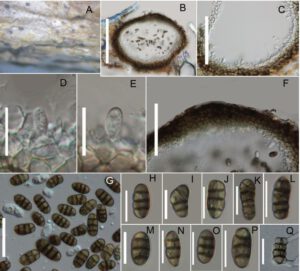Camarosporium spartii Trail, Scott. Natural., N.S. 3 (‘9’): 222 (1888)
Index Fungorum number: IF 121444; Facesoffungi number: FoF 00003
Saprobic on Cytisus sp. Sexual state: Not observed. Asexual state: Conidiomata pycnidial, 250−300 μm diam., 200−225 μm high, solitary, dark brown, immersed, unilocular, with papillate and centrally located ostiole. Pycnidial outer wall 3−4 layered, dark brown to black, composed of cells of textura angularis, with inner wall 1−2 layers, hyaline to pale brown. Conidiophores absent. Conidiogenous cells enteroblastic, annellidic, smooth, short, hyaline, segregated, formed from the inner layer of the pycnidial wall. Conidia 16−13 × 6−7 μm (mean = 14.3 × 6.6 μm, n = 20), oblong to ellipsoid, straight to curved, 3−4-transverse septate, occasionally with 2−3 longitudinal septa, smooth, brown to dark brown.
Culture characteristics — On PDA, slow growing, white, circular, smooth margin, attaining a diam. of 1.5−2 cm after 7 days at 18−20ºC.
Material examined — ITALY. Forlì-Cesena Province: Poggio Montironi – Santa Sofia, on dead stem of Cytisus sp. 7 July 2013, E. Camporesi, NNW IT 1369 (MFLU13-0340), living culture MFLUCC 13-0548 = ICMP 20050 = HGUP_2.
Notes — Trail (1888) introduced Camarosporium spartii on Cytisus sp. from Portugal. The same species was collected on the same host from Italy and is identified based on the morphology of the conidia.

Figure 1. Camarosporium spartii (MFLU 13-0327). A. Conidiomata on Cytisus sp. B. Cross section of pycnidium. C, F. Pycnidium wall. D, E. Developing conidia attach to conidiogenous cells. G–P. Conidia. Q. Germinating conidium. Scale bar: B = 200 μm, C = 80 μm, D, E = 15 μm, F = 40 μm, G = 20 μm, H–Q = 10 μm.
